Items tagged with 'blight fight'
A look inside 2 Judson Street

We got a chance this week to stop by the open house for 2 Judson Street, one of the properties that's for sale as part of the Albany County Land Bank's Neighbors for Neighborhoods program (a few details about that program below).
There are handful of photos to go along with this post, in case you'd like to gawk. Because, you know, we definitely wanted to gawk.
The property is part of the McPherson Terrace row on Clinton Ave in West Hill, a string of buildings (not all have survived) that date to the late 1880s/early 1890s. And they're related to Albany architectural royalty: The great Albany architect Edward Ogden participated in developing the strip. (Ogden and his son Charles, also an architect, designed a bunch of beautiful buildings around the city.)
A push to turn vacant buildings into owner-occupied homes -- with some help and coaching

351 Clinton Ave is one of the properties that's part of the program. / photo: Albany County Land Bank
The Albany County Land Bank is starting up a program with the goal of helping people renovate vacant properties and become homeowners. Blurbage for the Equitable Ownership Pilot Program:
EOPP aims to increase opportunities for homeownership in neighborhoods with large concentrations of vacant properties. The majority of the Land Bank's real estate acquisitions are in economically distressed neighborhoods where most residents are people of color. For decades, these neighborhoods have had disproportionately low levels of homeownership, created in large part by discriminatory housing practices dating back to the 1930s. A recent analysis by the Urban Institute on the gap between white and black homeownership rates in the 100 American cities with the highest number of black households found that the City of Albany has the second widest gap of all cities included in the study.
The initial phase of EOPP consists of five single or multifamily residential buildings located in the City of Albany. Buildings selected for EOPP are in economically distressed neighbors and require a low to moderate amount of rehabilitation relative to other properties in the Land Bank's inventory. Future phases of the program will be expanded to the cities of Cohoes and Watervliet, based upon property availability. Under the program, qualified applicants will receive a 15% discount off the listing price or a seller's concession of equal value to support the rehabilitation of a participating property, along with reduced closing costs.
Buyers will be paired with a "Rehabilitation Mentor" who will assist with creating a redevelopment plan and provide support during the rehabilitation process - from kickoff to close out - which typically takes 12 months. Buyers must provide evidence of sufficient financial capacity to complete the rehabilitation project prior to purchasing a property and will be paired with available resources if applicable.
Albany County Land Bank successful buyer workshop
 The Albany County Land Bank has a "Successful Buyers Workshop" coming up February 22 for people who might be interested in buying a land bank property. Blurbage:
The Albany County Land Bank has a "Successful Buyers Workshop" coming up February 22 for people who might be interested in buying a land bank property. Blurbage:
Here success stories from land bank home owners
Learn more about applying for land bank properties
Learn about rehabs, new construction, and more!
The workshops is Thursday, February 22 at 6:30 pm at the 200 Henry Johnson Blvd building in Albany. It's free.
Land bank?
Very short: The land bank is an independent org that works to shepherd vacant or abandoned properties that have been seized by the county in tax foreclosure into the hands of people can rehab the buildings and put them back into productive use. It's now sold 200 properties since it started up in 2014.
Albany now has a better sense of how many vacant buildings it has -- and a common starting point for taking on the problem
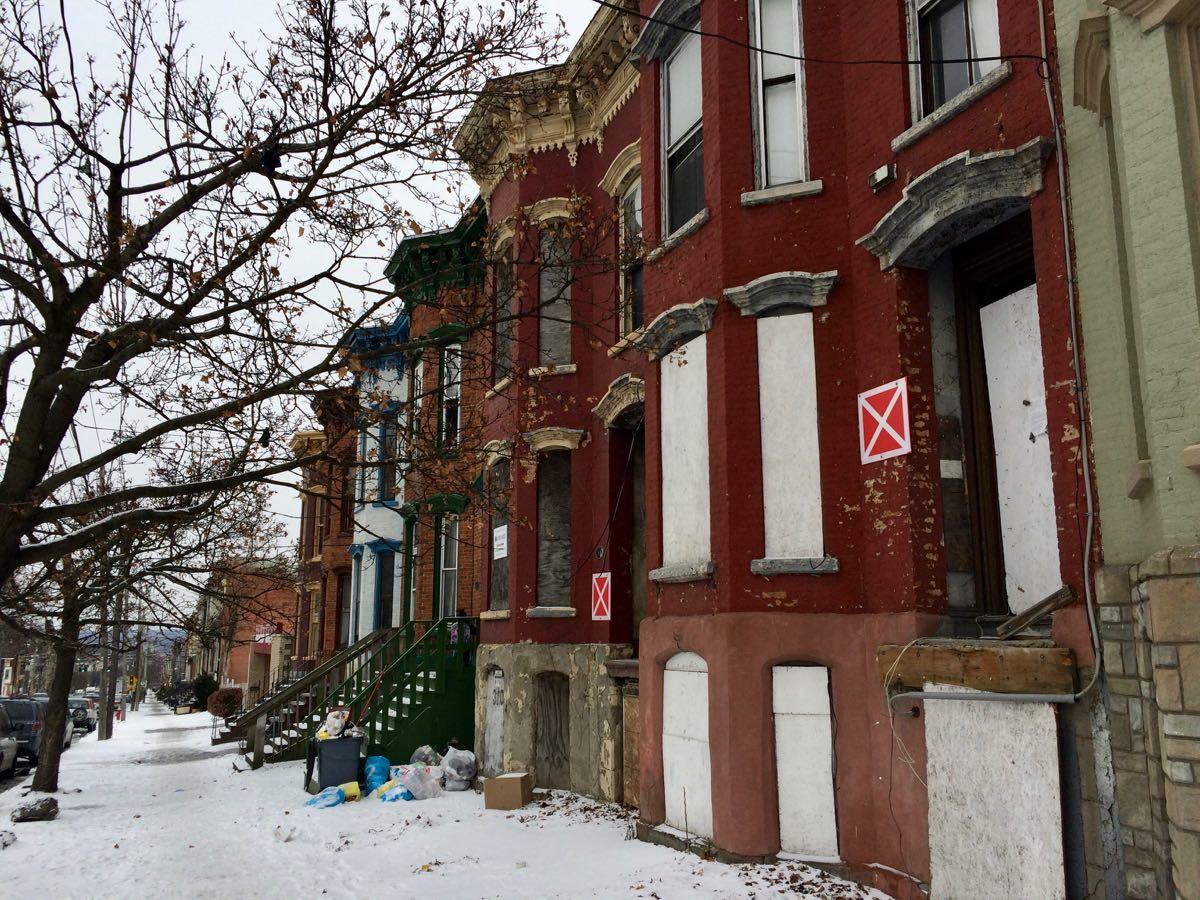
Clinton Ave in West Hill.
What's been clear: The city of Albany has a lot of vacant buildings.
What's not been clear: Exactly which buildings are vacant, and what's the actual total number of them.
But the city now has a new vacant building list, and it's probably the best, most accurate estimate in years.
It's part of a larger process to more proactively take on issues such as vacant buildings, code enforcement, and neighborhood development.
A city lot for $100
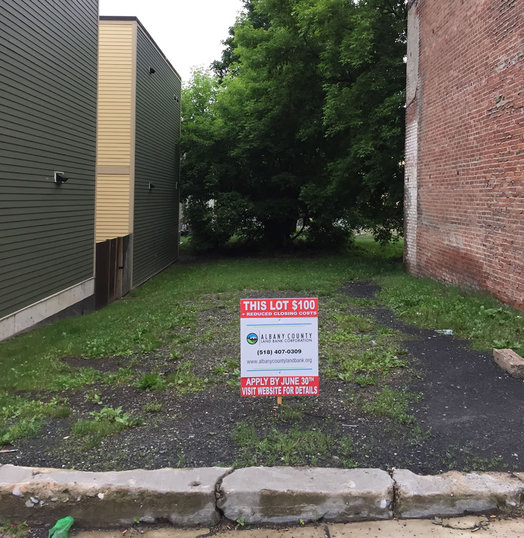
One of the lots up for sale is on Fourth Ave in the South End. / photo via Albany County Land Bank
The Albany County Land Bank is selling off a handful of vacant lots around the city of Albany for $100 each (plus a few other costs) in a program it's calling... "Spend a little, get a lot!"*
The application process starts today, June 1, and runs through June 30. Press release blurbage:
The Land Bank has identified 40 tax-foreclosed, vacant lots to participate in the program. Most of the lots are located in the Land Bank's Focus Areas: the Arbor Hill, Sheridan Hollow, South End, West End and West Hill neighborhoods in the City of Albany. To be eligible, buyers must be property owners located on the same block as the participating lot and must be current on all taxes, water/sewer bills, and have no outstanding code violations or unresolved foreclosures. Preference will be given to applications based on factors including proximity to the lot and ownership status. Buyers will have 30 days from the date of purchase to ensure the property meets all City of Albany codes and will be required to retain ownership of the property for a period of five years.
The land bank link above has a map of the vacant lots, along with a detailed info page explaining eligibility and some of the additional costs involved. (Though the purchase price is just $100, total costs will be at least $700.)
Vacant lots are kind of like missing teeth in a streetscape, especially in dense neighborhoods. Bringing some sort of activity to them -- a garden, a neighborhood gathering space, just some regularly-mown grass -- can be a big help to a street.
Land bank?
Land banks are a relatively new concept. The idea is that they serve as a bridge between when a vacant property is seized in tax foreclosure and when it's bought by a new owner for renovation and/or redevelopment. Land banks acquire the properties, stabilize them, and then market them for sale with the aim of finding buyers who will redevelop them responsibly. The orgs can also "bank" properties (thus the name) to group them or otherwise set them up for better chances of successful development.
The Capital Region has three land banks: Albany County Land Bank, Troy Community Land Bank, and Capital Region Land Bank (Schenectady and Amsterdam).
* (rimshot) They'll be here all week.
A chunk of money for chipping away at the number of vacant buildings in Albany
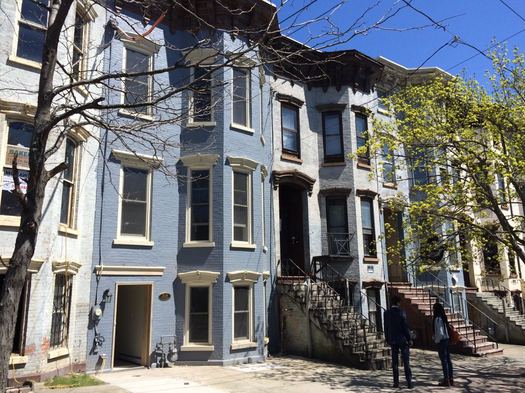
The blue building on the left is an Albany County Land Bank property has been rehabbed by Habitat for Humanity Capital District -- the one on the right is another land bank property.
The city of Albany is offering $50,000 to people looking to take on the challenge of fixing up a vacant building and putting it back to use.
Kathy Sheehan mentioned the initiative -- the aptly-titled Vacant Building Rehabilitation Program -- during her state of the city address early this year. And on Tuesday the city released the details of the program, which is backed by $1 million.
Albany County Land Bank buyer workshops

A property on Roosevelt Street in Albany recently acquired by the Albany County Land Bank. / photo courtesy of the ACLB
The Albany County Land Bank has a few workshops coming up for people who might interested in buying one of its properties. Blurbage:
In this workshop Virgina Rawlins, our Housing Counselor, will walk you through your application and answer any questions. This workshop is important to all who are interested in purchasing a property from the Land Bank and for those who are considering purchasing a property; every individual will go through the same process.
The workshops are:
+ Monday, April 3 at the Albany Public Library Washington Ave branch at 6 pm
+ Wednesday, April 19 at 255 Orange Street at 6 pm
The land bank website displays available properties in both list and map form. And here's a map of land bank properties in their various states -- from evaluation in progress to sold. Many of the properties are in the city of Albany, but others are spread around the county.
The Albany County Land Bank website currently lists about 20 available properties, both buildings and vacant lots. But there are lot of properties in the pipeline -- the land bank recently announced it had acquired 265 properties in the city of Albany.
Land bank?
Land banks are a relatively new concept. The idea is that they serve as a bridge between when a vacant property is seized in tax foreclosure and when it's bought by a new owner for renovation and/or redevelopment. Land banks acquire the properties, stabilize them, and then market them for sale with the aim of finding buyers will redevelop them responsibly. The orgs can also "bank" properties (thus the name) to group them or otherwise set them up for better chances of successful development.
The Capital Region has three land banks: Albany County Land Bank, Troy Community Land Bank, and Capital Region Land Bank (Schenectady and Amsterdam).
Earlier:
+ The push to breathe life into the buildings that breathed light
+ Bringing Albany buildings back from blight and making them into owner-occupied homes
New life for buildings in Schenectady's Eastern Ave neighborhood -- and aspirations to lift the whole neighborhood
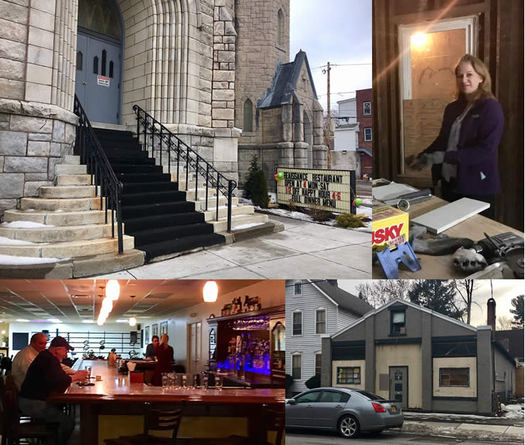
Schenectady's Eastern Avenue neighborhood, a residential strip not far from downtown and Union College, has been struggling for years with blighted buildings and closed businesses.
But several people are now looking past the deterioration and neglect, instead focusing on the potential behind the century-old homes and historic structures. They're investing money and time toward bringing new life to individual properties, hoping to lift the entire neighborhood.
Here's a look at a handful of people and projects.
The push to breathe life into the buildings that breathed light
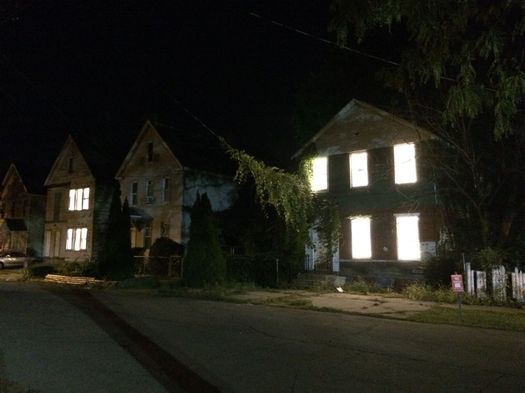
Now that the vacant buildings in Albany, Schenectady and Troy are no longer "breathing" light, what's next for the properties?
The land banks in the three cities, along with the cities themselves, are working to connect potential buyers with the homes in the hope they'll be repaired and occupied.
How's that going so far?
How 27 properties in a Troy neighborhood ended up in a shaky situation -- and the complicated path back to solid footing
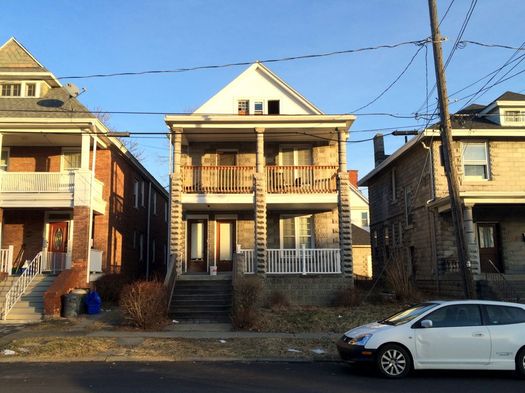
One of the properties on Fourteenth Street.
On January 12, 2012, Rensselaer Polytechnic Institute in Troy issued an emergency notification, advising students who rented off-campus housing from a company called Campus Habitat "that the continuation of their ability to reside in that residence may be in immediate jeopardy." Campus Habitat had not paid its mortgage, utility bills, or real-estate taxes for several months, and was "involved in a large similar foreclosure lawsuit" near a school in Illinois, the alert advised.
Some 200 students escrowed or withheld rent; many sought new housing. And the memo was prophetic: Within weeks, the student-rental company's largest area lender, SEFCU, posted foreclosure notices on the doors of 27 homes.
Today students still occupy most of these homes, but it wasn't a straight path to this point. Sited in teetering neighborhoods in a city never far from "fiscal chaos," this critical assemblage of student housing, over the past half decade, has entailed a tangle of litigation, a protracted sale period, a surprise intervention, and millions of dollars in public and private investment -- all to overcome the actions of a landlord who profited at the community's expense and left a sizable chunk of the neighborhood untended.
Bringing Albany buildings back from blight and making them into owner-occupied homes
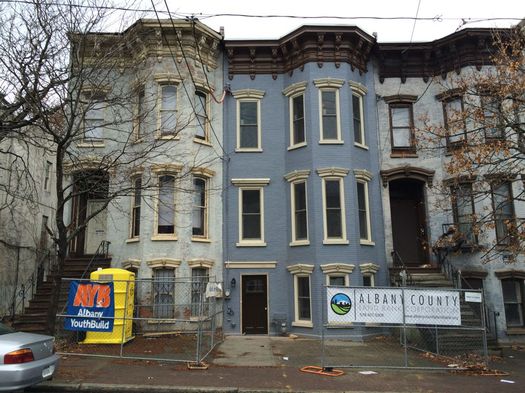
The renovated row home on Clinton Ave in Arbor Hill.
When Habitat for Humanity comes up, the image that probably pops into a lot of people's minds is that of a volunteer org getting together on weekends and building small houses, one at a time.
But, as we've mentioned before, Habitat for Humanity Capital District has been working in recent years as something more like a neighborhood developer, doing large-scale projects such as the ongoing redevelopment in Sheridan Hollow.
Now Habitat for Humanity Capital District is evolving again, this time working to renovate blighted buildings in the city of Albany back into owner-occupied homes.
... said KGB about Drawing: What's something that brought you joy this year?